|
|
Torna alla home page Back to the home page |
|---|
| Having trouble viewing this email? Click here |
|
||
|---|---|---|
|
ITALIAN SHUAI JIAO
UNION |
| HISTORY | CHANG TUNG SHENG | CHANG DA WEI | TAI CHI CHUAN | ORGANIZATION |
|---|---|---|---|---|
| VIDEOS | PHOTOS | STAGE | TOURNAMENT | PROGRAM |
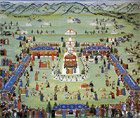 Shuai-jiao
(pronounced Shuai-Jiao), can be defined the Everst mount of the Chinese
martial art, is a famous style that kills in its sublimity of product
of Kung-fu Wushu. This old technique includs a combination of every
effective trick in soccer, taken, blows and projections known like:
Shuai the projection projecting, Na to seize, Tien fatal point and to
hit. Shuai-jiao
(pronounced Shuai-Jiao), can be defined the Everst mount of the Chinese
martial art, is a famous style that kills in its sublimity of product
of Kung-fu Wushu. This old technique includs a combination of every
effective trick in soccer, taken, blows and projections known like:
Shuai the projection projecting, Na to seize, Tien fatal point and to
hit. However the Shuai-jiao has not been considered in the history until hat was not used from the yellow Emperor Huang-You (2690 a.c.), in order to defeat its enemy legendary Chih-Yiu. The highest art from combat called Chiao-ti to that time, other names was given subsequently following the current dynasties. The Chinese fighting between tribal invasions and wars have used this ancient system, in last the 2000 years, have created four greater local styles that are: Beijing, Paoting, Tienjin and Mongolia. Inside of these greater styles was been, previously, of the variations becoming the better system, in the body to body. 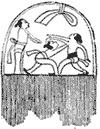 Subsequently
with the Cheu dynasty (1134 a.c.), the technique to the famous hour
like jiao-Them, made an important run in the training of the soldiers.
With passing of the time, it became very more popular around to the 264
a.c., not only the Shuai-jiao exists like preponderant sport, is in the
civil activity that in the military, but has been also assessed to be
to regulate entertainment of the monarchy. Subsequently
with the Cheu dynasty (1134 a.c.), the technique to the famous hour
like jiao-Them, made an important run in the training of the soldiers.
With passing of the time, it became very more popular around to the 264
a.c., not only the Shuai-jiao exists like preponderant sport, is in the
civil activity that in the military, but has been also assessed to be
to regulate entertainment of the monarchy. Towards the 140 a.c the Shuai-jiao caught up new levels, Wu Emperor of the Han dynasty, therefore was gotten passion of this art that called "Permanent the Real Recreation". During its reign, it created around to it a such enthusiasm that people from every part made also 500 miles in order to see the tournament of Shuai-jiao, to that time its name was Chiao-Ti. Of generation in generation this Monarchic technique was exceeded. That laughed them to the Shuoi dynasty or Sui (610 d.c.). In the sixth year of the reign of Young Emperor, a national contest was held in the Tuan-Mon roads, the event lasted thirty days is the same Emperor was a frequent visitor.  It
was therefore that the tradition was adopted annually, was a meeting or
an international tournament every fifteen of the first month of the
calendar, going ahead regularly this conventional art refers more and
more in the ancient Chinese Art. It
was therefore that the tradition was adopted annually, was a meeting or
an international tournament every fifteen of the first month of the
calendar, going ahead regularly this conventional art refers more and
more in the ancient Chinese Art. Kao-Tsu Emperor (618 d.c.) of the Tang dynasty, a great politician to those times, decided to move the tournament of Shuai-jiao in warmer periods, and ordered that the games came carried out the fifteen of 17th the month of the Chinese calendar. The first books on the fight of the Shuai-jiao, one of the more important happened in the period of the dynasty of Song (760 d.c.) was "Jiaoli-Ji", the book of the fight that of it introduces the history, the theories, the techniques, all was attributed to Dia-Luzi. 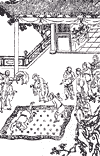 During
the time of Kubla-Khan (1216 d.c.) this art was pushed to an other
height. Other names came given to it like: Poh-Ho, Tsong-Chiao,
Kuang-Chiao, Hsiang-Pu. The characters used for the Hsiang-Pu, are the
same ones in Japan in order to denote the Sumo, that it is the Japanese
traditional fight. During
the time of Kubla-Khan (1216 d.c.) this art was pushed to an other
height. Other names came given to it like: Poh-Ho, Tsong-Chiao,
Kuang-Chiao, Hsiang-Pu. The characters used for the Hsiang-Pu, are the
same ones in Japan in order to denote the Sumo, that it is the Japanese
traditional fight. The Japanese arts were a lot influenced from the art of the Shuai-Chiao, especially the birth of the Ju-Jitzu, thanks to one great encyclopedia "Wanbao-Quanshu" written on Imperial order of the reign of Wali Emperor (1573 d.c.) of the dynasty of the Ming. Arriving towards the end of the dynasty of the Ming (1644 d.c.) while the invaders of the Manchuria were spreading, native of That, called a Cheng kianng -Pin 52 years old , bond in the boxing and in the Shuai-jiao, he was sent in Japan with its connects Chu Shum-Shei and Lee Mei-Shi. Under the political pressure that was in that period in China, was sheltered in temple Buddhist in which they taught to three Samurai students of name: Fukunoshiehilo-Wuemon, Mirulayosi-Wuemen and Isomizile-Saemon, the techniques of Shuai-Chiao that later on founded everyone an own school of Ju-Jitzu, of which the Kito-Ryu it was one of the origins of the modern Judo. Moreover the creator of the Yoshin-Ryu school was a Japanese doctor who had acquired its knowledge in China. 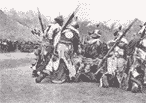 In
the dynasty Qing or Ching (1644-1911 d.c.) this fantastic art became
the most considered in the Monarchic activity, the new ones reigning of
this poor Art on a field of good combatant that called Shan-Pu Ying
where they had three hundred squares, these expert Young soldiers was
calls "Young Tigris" of Shuai-jiao, ready every time to you for
entrateniment real, national foreign transfers and tournament.
Mongolian and Tibetan tribal squares of champions, and other districts
you fight to you, often came sends to you to attend the field. In
the dynasty Qing or Ching (1644-1911 d.c.) this fantastic art became
the most considered in the Monarchic activity, the new ones reigning of
this poor Art on a field of good combatant that called Shan-Pu Ying
where they had three hundred squares, these expert Young soldiers was
calls "Young Tigris" of Shuai-jiao, ready every time to you for
entrateniment real, national foreign transfers and tournament.
Mongolian and Tibetan tribal squares of champions, and other districts
you fight to you, often came sends to you to attend the field. 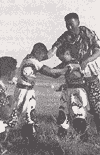 After
that this Republic was established in 1911, the Shuai-jiao was
scattered is to the north that to the south of China, a governor of
name Ma-Liang of the province of Shan-Tung, a battalion of Martial
Artists organized and gave to Shuai-jiao like name to this traditional
technique and churches to its to teach it. After
that this Republic was established in 1911, the Shuai-jiao was
scattered is to the north that to the south of China, a governor of
name Ma-Liang of the province of Shan-Tung, a battalion of Martial
Artists organized and gave to Shuai-jiao like name to this traditional
technique and churches to its to teach it. After the fall of the dynasty of Ching (1912 d.c.) a name general Chang Who in 1928, formed an Institute Centers them of Kuoshu to Nanking or Nanjing, and the Shuai-jiao was a course asked the students, selects from every province local for training of hight level. Subsequently in the 1928 decided of giving a definitive name to this system, then the Shuai-jiao name is known like such until the days ours. Anciently in the dialects local they came used until 87 names for this ancient system.  Today
the pure essence of the traditional art of the Shuai-jiao, has been put
from part, is known that is like taken Na-Shuai and projection, is on
this base that athletes are moderate themselves in National and
International tournament. The Shuai-jiao miliarey stone in the
development of the Chinese Martial arts, to data the bases to styles
like the Shaolin Chuan and the Tai Chi Chuan for their applications. Today
the pure essence of the traditional art of the Shuai-jiao, has been put
from part, is known that is like taken Na-Shuai and projection, is on
this base that athletes are moderate themselves in National and
International tournament. The Shuai-jiao miliarey stone in the
development of the Chinese Martial arts, to data the bases to styles
like the Shaolin Chuan and the Tai Chi Chuan for their applications.  Currently
the style of the Shuai-jiao is diffused in the (P.R.C.) Republic
Popular China and in the (R.O.C.) China Republican. Little masters
exist still today who teach traditionally the art of the Shuai-jiao,
and are the directed descendants of the Bao-Ding Kuai-Jiao style. The
others three branches of the Shuai-jiao come mainly transmitted to
sport level. In many university cities, schools, institutes standard
this ancient style, integrating part of the Chinese traditions,
remained pure in the passage of milleniums. Currently
the style of the Shuai-jiao is diffused in the (P.R.C.) Republic
Popular China and in the (R.O.C.) China Republican. Little masters
exist still today who teach traditionally the art of the Shuai-jiao,
and are the directed descendants of the Bao-Ding Kuai-Jiao style. The
others three branches of the Shuai-jiao come mainly transmitted to
sport level. In many university cities, schools, institutes standard
this ancient style, integrating part of the Chinese traditions,
remained pure in the passage of milleniums.Styles of Shuaijiao Shuai-jiao can be divided into six styles, four major and two minor: Beijing Style- This is in essence the lineage from the Manchu Buku style that was practised by the Imperial Palace Guard, Shan Pu Ying (善扑营, literally the Expert in Wrestling Unit). The main characteristic is the use of the legs to kick and off-balance opponents. It is considered a gentler style than the Tianjin Style. Tianjin Style- This is the lineage of Ming Dynasty Shuai-jiao mixed with Manchu Buku. The main characteristic is the use of legs to kick and off-balance. It is considered a harder and rougher style than the Beijing Style. Baoding Style- This is the lineage that is called Kuai-Jiao (Fast Wrestling). The main characteristic is the fast application of technique. Another characteristic is the adaptation of Shaolin Quan from Ping Jingyi, a famous teacher of Shuai-jiao who learned Shaolin style from the Meng family of Nanguan County even though he was a Muslim Hui. The above three styles are sometimes called Hebei Style Shuaijiao or simply Shuai-jiao. Wrestlers wear a jacket called Shuai-jiao-Yi. Mongol Style - This is the lineage from Mongol Boke. The two styles of shuai jiao secondary: Shanxi Style -This is the lineage of Song Dynasty Shuai-jiao. It is mainly practised in the counties between the mining city of Datong in northern Shanxi and the provinvial capital Taiyuan in central Shanxi. The main characteristic is leg catching techniques, as traditonally wrestlers wear only tight knee-length pants. Xinjiang Style - This is the lineage from various Turkic styles. The main characteristic is waist techniques. |
 European Shuai Jiao Union - For informations: telephone number +39 347 1212266 Master Antonio Langiano - President of the European Association email: italy.kuoshu@hotmail.it |